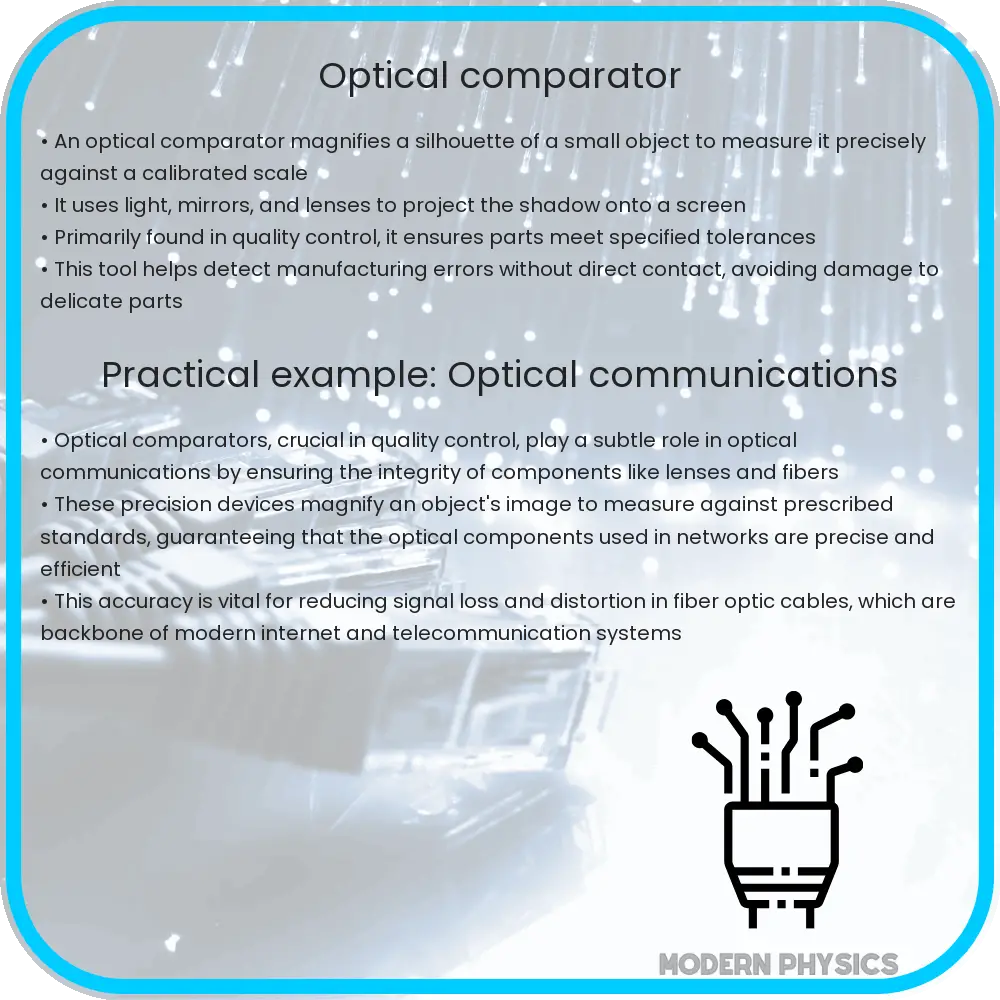Learn about optical comparators, precision measurement devices used widely in manufacturing for detailed inspections of complex components.

Understanding Optical Comparators
An optical comparator, often referred to as a profile projector, is a crucial tool in the field of metrology, which is the science of measurement. This device uses the principles of optics to magnify and project the shadow of a small object onto a screen for visual measurements. Optical comparators are widely utilized in manufacturing environments where precision is paramount, such as in the production of automotive and aerospace components.
Key Features of Optical Comparators
- Precision: Optical comparators provide high precision in measurement, typically in the order of micrometers. This allows for the detailed inspection of minute features that are crucial in high-quality manufacturing.
- Magnification: These devices can magnify objects from 10 times up to 100 times their actual size, depending on the system setup. Higher magnifications allow for more detailed inspections and precise measurements of small and intricate features.
- Measurement Capabilities: Optical comparators can measure dimensions, angles, and radii of objects. They are versatile in that they can handle both two-dimensional measurements and more complex geometrical inspections.
How Optical Comparators Work
The basic operation of an optical comparator involves projecting a beam of light onto an object. The light passing around the object creates a silhouette, which is then magnified and projected onto a screen. Measurement markings on the screen enable technicians to measure the dimensions of the object directly or via digital means.
Different types of lighting methods, such as transmitted light (light that passes directly through the sample) and reflected light (light that illuminates the sample from above), can be employed depending on the nature of the object being examined.
Applications of Optical Comparators in Industry
Optical comparators serve a wide range of applications across various industries. They are predominantly used in:
- Automotive: For measuring engine parts, gears, and other components with complex shapes.
- Aerospace: For ensuring the precision of aircraft components which must adhere to strict dimensional tolerances.
- Electronic: For inspecting circuit boards and other electronic assemblies where precision is crucial for functionality.
These instruments not only enhance quality control but also significantly reduce the time taken for inspection compared to traditional measurement methods. Thus, they play an instrumental role in improving manufacturing efficiency and product quality.
Advancements in Optical Comparator Technology
Technological advancements have significantly improved the functionality and accuracy of optical comparators. Modern devices often include digital enhancements such as:
- Computer Integration: Many optical comparators are now integrated with computers, allowing for automatic data capture and analysis. This integration helps in storing measurement data and facilitates detailed reporting and quality control processes.
- Software Features: Advanced software can enhance the capabilities of an optical comparator by providing features such as automatic edge detection, image analysis, and more precise measurement tools.
- Video Comparators: Some modern variants use video technology to capture real-time images of the object, which are then projected onto a high-resolution monitor instead of a traditional screen. This method improves visibility and accuracy.
Choosing the Right Optical Comparator
When selecting an optical comparator, it is important to consider several factors to ensure it meets specific industrial needs:
- Measurement Needs: Assess the typical size and type of objects that will be measured. This consideration will help determine the necessary range of magnification and measurement capabilities.
- Environment: The environmental conditions of the manufacturing area, such as lighting and space constraints, can influence the type of comparator and its features.
- Budget: Optical comparators vary in price, depending on their features and precision. Therefore, it’s crucial to balance budget constraints with the specific needs of your manufacturing process.
Conclusion
Optical comparators are indispensable tools in the modern manufacturing landscape, offering unparalleled precision and efficiency in quality control processes. By understanding their functionality, key features, and applications, industries can make informed choices about integrating these instruments into their operations. As technology advances, the enhancements in optical comparator systems continue to evolve, further aiding industries like automotive, aerospace, and electronics in maintaining the high standards necessary for their products. Furthermore, the adoption of advanced features such as digital capabilities and computer integration facilitates a more streamlined, accurate, and faster measurement process. Ultimately, the strategic use of optical comparators not only supports adherence to strict quality standards but also significantly contributes to advancements in manufacturing precision and efficiency.
